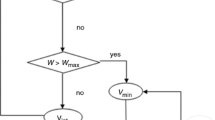Abstract
Egyptian Portland Cement in the form of one inch cube was hydrated at different times of hydration. Nine cubes of each period of hydration were heated for five minutes 200, 300, 400 up to 1000°C then were quenched in air. The compressive strength was measured for these samples and related to unheated ones. These cubes were ground and measured by Mössbauer spectrometry to correlate the effect of dehydration of cement pastes on the states of iron, with the decrease of compressive strength. It was observed that starting from 400°C the central doublet characteristic of the hydration process decreased as the dehydration temperature was increased. At 1000°C the dehydration process was complete, the central doublet disappeared and the compressive strength vanished. The hydration process was found to be reversible. The application of Mössbauer spectrometry to estimate the degree of fire in concrete building was demonstrated.
Similar content being viewed by others
References
A.M. Neville, Properties of concrete, 3rd Edition, The English Language Book Sociey, (1983).
C.N. Nagaraj, and A.K. Sinha, Heat — resisting concrete, Indian Concrete J., 48, No. 4, pp. 132–7 (April 1974).
M.S. Abrams, Compressive Strength of concrete at temperatures to 1600°F, Temperature and concrete, Amer. Concr. Inst. Sp. Publicn. No. 25, pp. 33–58 (1971).
D. Whiting, A. Litvin, and S.E. Goodwinn, Specific heat of Selected concretes, J. Amer. Concr. Inst., 75, No. 7. pp. 299–305 (1978).
P. Smith, Resistance to high temperatures, ASTM Sp. Tech. Publicn. No. 169B, pp. 388–419 (1978).
J.A. Rhodes, Thermal Properties, ASTM Sp. Tech. Publicn. 169B, pp. 242–61 (1978).
D.R. Lankard, D.L. Birkimer, F.F. Fondriest, and M.J. Snyder, Temperature and concrete, Amer. Concr. Inst. Sp. Publicn. No. 25, pp. 59–102 (1971).
S. J. Schneider, J. Amer. Ceram. Soci., Vol. 42, No. 4 (1959).
F. Pobell and F. Wittmann, Z. Angew Physik, 20, 488 (1966).
N.A. Eissa, M.Y. Hassaan, H.A. Sallam, S.H. Salah and S.A. Abo-El-Enein, TIZ-Fachberichte, 106, No. 9, 664–665 (1982).
N.A. Eissa, M.Y. Hassaan, H.A. Sallam, S.H. Salah and S.A. Abo-El-Enein, J. Mater. Sci. Lett., 3, 88–90 (1984).
Author information
Authors and Affiliations
Rights and permissions
About this article
Cite this article
Hassaan, M.Y., Salah, S.H. & Eissa, N.A. Study of the dehydration of Portland Cement by Mössbauer spectrometry. Hyperfine Interact 46, 733–738 (1989). https://doi.org/10.1007/BF02398266
Issue Date:
DOI: https://doi.org/10.1007/BF02398266




